What is customer experience marketing?
Customer experience marketing is a strategy that focuses on delivering consistently positive customer experiences at all points of contact and not just at the time of purchase.
It seeks to understand customers’ preferences at different journey stages, manage interactions at physical and digital touchpoints and deliver personalized experiences that foster an emotional connection with the brand.
Customer experience marketing (CEM) is crucial in today's business landscape, given that customers engage with your brand both before and after a purchase. Creating a memorable and positive experience during pre-purchase interactions can significantly influence their purchase decisions; positive experiences post-sales — whether through service interactions, customer care or online engagement — can help with repeat sales, positive reviews, higher net promoter score (NPS) and customer satisfaction scores, converting your customers into brand advocates.
70% of customers would pay more if they knew they would receive a convenient experience. |
Examples of good customer experience strategy
Before we dive into real-world examples of exceptional customer experience marketing, here are some ways you can improve your CX with respect to customer service operations.
Foster a customer-centric culture across your organization and ensure customers are always at the heart of your operations, to deliver great experiences constantly.
Ensure customers have easy and constant access to support by providing 24/7 omnichannel customer service across traditional and modern support channels.
Understand customer needs and personalize care through customer interaction analytics — and know well about user behavior and preferences.
Provide timely responses to customer queries and reviews across all communication platforms to ensure your customers feel valued.
Constantly measure and monitor critical metrics to identify any issues in performance, and refine your strategies based on insights from this data.
Make customer feedback a part of your operations — regularly collect feedback through customer surveys and know how to make your products and services better.
Businesses worldwide are taking customer experience marketing seriously, banking on its effectiveness and insights to improve their customer service quality as well, which in turn improves their overall CX. Here are some ways brands have implemented positive CX changes with their customer base.
Slack: Slack, a popular cloud-based communication platform, focuses on user-centric design and seamless onboarding to deliver simple, powerful customer experiences. Their strategy emphasizes simplicity, enabling effortless collaboration within teams. With self-service and learning resources like interactive tutorials and knowledge base, they ensure users quickly grasp the platform's capabilities — enhancing productivity and satisfaction in the workplace and converting their customers into brand loyalists.
Adobe Creative Cloud: Adobe's Creative Cloud excels in customer experience through its "Creative Residency" program. This initiative involves selecting aspiring artists to work on projects using Adobe tools while providing them mentorship and exposure. By nurturing emerging talent among their customer and showcasing the potential of their software, Adobe strengthens brand loyalty and fosters a vibrant community of creatives — while also delivering enriching experiences that their customers will never forget.
Airbnb: Airbnb strives to offer superior CX despite limited control over listed properties. Airbnb is a rental services platform and ensuring uniform CX is often difficult since the brand does not own the properties. Yet, the company seeks to offer superior CX every time by providing similar welcome experiences and being responsive to customers’ needs. Airbnb has adopted an extensive omnichannel customer service approach, delivering customer care on multiple channels including email, phone, social media, messaging channels, chatbots and SMS. The company offers 24/7, almost instantaneous support using these channels. They also meet with customers and hosts during the event “One AirBnB” to collect feedback.
Also read: Customer Experience Management: What is CXM & its Strategies
5 reasons why customer experience marketing is important
Customer experience marketing becomes the foundation for great customer relationships. It directly connects your user to your brand and its values, and makes them feel heard and seen — and it doesn’t just stop there. Below are some of the other key benefits of customer experience marketing.
1. Competitive advantage
Nothing can beat competition compared to the experience that you offer customers. Multiple positive experiences are required to make up for one negative customer experience, which will invariably affect your team’s efficiency. Beat your competition by providing experiences that customers will always cherish.
2. Builds customer loyalty
A positive CX ensures customer retention and loyalty. Consistent customer experience across multiple touchpoints enables a high customer retention rate, resulting in repeat visits, a positive brand image and long-term association with the company.
3. Drives revenue
Positive, satisfying experiences lead to customers spending more dollars per purchase. It also results in impulsive buys, resulting in higher revenue for the company. The average customer lifetime value (the total amount a customer spends with your business over a lifetime) is also higher when you offer positive experiences.
4. Reduced costs
While providing a unified customer experience can seem costly, it in fact reduces the cost of customer acquisition and retention. By building customer loyalty, attrition is reduced and your retention costs also go down. This improved CX can even serve as a competitive edge for your brand, which will help bring down acquisition costs since your audience will seek your brand by themselves.
5. Higher brand equity
Brand equity refers to the brand’s value in the eyes of the customers. Customer satisfaction and brand equity are higher when a brand delivers on its promises, provides quality products and is responsive to customers’ needs.
High brand equity also helps with damage control in times of crisis and with escalations. Customers will find it easier to trust your service again because of the numerous positive experiences they’ve had, also helping them re-establish trust in your brand very easily.
Challenges of customer experience marketing
Although CEM sounds like a fairly straightforward function that can be implemented and executed easily, several factors might affect your CX and the way your business functions in general. Below are some challenges one might face while developing a solid CEM strategy that aims to provide great CX.
Data privacy issues: In an attempt to engage with the customers each time they visit your website, social media pages or store, you may end up overwhelming them and breaching their privacy.
Enabling customer self-service is a surefire way to reduce friction and customer frustration since not many users prefer a bot or sales representative following them around to help. Use data to segment customers based on their preferences and then prepare specific CEM strategies for each segment.
Cost and time: CEM requires investment in resources and time. You must invest in technology solutions to collect customer preference data and run necessary campaigns on various platforms. Moreover, consistently doing it means the CEM budget is an ongoing spend rather than a one-time budget, like for a marketing campaign.
Data constraints: Data is the key to building successful CEM strategies. You need data on customer preferences and behavior to improve customer experience. Wrong or outdated data can result in your CEM strategy backfiring. Additionally, you also need to invest in data security tools to ensure compliance with regulations wherever customer data is collected and stored.
💡 Pro Tip: Replacing multiple-point solutions with a unified customer experience management solution for all functions — especially sales, marketing and support — helps reduce your costs and ensures easy flow of data across teams and functions. |
6 key elements of customer experience marketing
Customer experience marketing strategy needs to be scrutinized before implementation. Disconnected experiences lead to customer dissatisfaction and higher attrition. You must prepare detailed roadmaps of your customer experience strategy before investing in them.
Here are some key elements essential to customer experience marketing:
1. Customer personas
Understanding the demographics, interests and behavior of your customers is the key to delivering engaging digital customer experiences. Build personas for your different customer types by studying their content preferences, device usage, satisfaction drivers and decision-making processes.
Create tailored customer experience programs for your different customer personas. For example, a company selling anti-virus software will have to deal with both individual customers and other businesses and their buying patterns and needs will be very different.
2. End-to-end customer journey mapping
Customers take different routes to reach your brand and make a purchase. Mapping customer journeys using data-driven solutions will help you understand the touchpoints and what actions need to be taken at each touchpoint.
It’s best for you to revisit your customer journey maps periodically — maybe once in six months or once a year — since customer preferences and the market environment keeps evolving and your customer journey might have to be modified accordingly.
Read more: How to do customer journey mapping for CX improvement
3. Service availability
The availability of services is key to ensuring a good customer experience. For example, if most of your customers cannot raise their service requests within the usual business day, ensure you have customer service professionals in the evening and night shifts as well.
Technology solutions such as chatbots, email autoresponders and interactive voice responses (IVR) help improve your customer service availability without costing much.
4. Accessibility of programs
While designing customer experience programs, make sure your resources are accessible to all types of prospects and clients. For example, your website user experience should be suited for global audiences – people with special needs, language and time zone constraints etc. Add elements to the experience to cater to a wider audience.

5. Iterations and service design improvements
Getting the customer experience journey right on your first attempt may not always be possible. Even if you do get it right, you still need to continuously work on it to ensure it stays relevant and is in line with the latest trends and technological advancements. Good CX is an iterative, ongoing journey — make sure you monitor your key customer experience metrics to optimize your CX continuously.

6. Customer data and social listening
Accurate customer data including information on customer interests, culture, aspirations, etc. is key to building engaging CX programs. Social listening can help detect customer perception about your brand or competitors via interactions on platforms such as Facebook, Twitter, Instagram and other networks.

Also read: 10 Customer Experience Management Quotes from Power Influencers
Interplay between marketing and CX
Often, the delivered customer experience and journey ends up different from the intended experience. It could be because of a variety of reasons — including budget constraints, inability to execute the planned experience or communication gaps between the teams involved.
That’s why the team(s) involved with working and formulating your CX should be closely associated with the marketing and sales teams. In most organizations, the CX teams sit within the marketing organization and share the same leader. This ensures the CX does not vary from the promised experience.
Here’s how you should stitch together your CX and marketing initiatives more closely:
Consistent and brand-compliant messaging: Customers today interact with your brand via multiple channels. The touchpoint timelines might also vary, especially with social media customer service. The marketing team must provide a consistent experience in terms of customer service quality, query resolution, product demos and content.
Having brand and style guidelines for customer communications and all marketing collateral can ensure uniform customer experience throughout customers’ purchase journey. This also helps induce brand recall.Data-driven strategies: Use data to build your CX strategy. This helps avoid opinion-driven CX marketing. Marketers often tend to see themselves in the customers, forgetting that there might be traits that differ. Using data from customer interaction analytics to build CX and marketing strategies can help avoid inconsistencies and wrong approaches.
Tight collaboration: Providing great customer experiences is the responsibility of every organization member. Share guidelines on customer interactions and CX programs. The CX team should collaborate with other marketing teams, sales, and other business functions to provide uniform customer experiences.
Why choose Sprinklr for customer experience management
Customers shift between channels when interacting with brands, and they expect brands to maintain continuity in conversations irrespective of the channel. This consistency and continuity is expected across all channels in the customer journey, which is difficult to achieve with point solutions and disconnected communication channels.
Unlike point solutions, Sprinklr’s unified customer experience management (Unified-CXM) platform enables brands to gauge the marketplace, build customer personas using data and provide a unified customer experience — all from a single platform. With Sprinklr Service, you can elevate your customer experience to the next level by delivering seamless, personalized conversations across your customer’s favorite channels.
Deliver exceptional customer experiences and manage them end to end with a powerful, unified platform
Provide customer service across 30+ traditional and digital channels with our omnichannel customer service solution
Enable agents to provide superior support with complete context using our Unified Agent Console
Leverage Sprinklr Service as an advanced customer service analytics and reporting solution that analyzes customer behaviors, preferences and patterns and helps provide relevant support
Ready to take Sprinklr for a spin? Sign up for a free, fully functional trial of Sprinklr Service and experience the potential of a unified customer experience management solution.
Frequently Asked Questions
Customer relationship management (CRM) includes the practices and strategies a business uses to manage and analyze customer relationships. Customer experience management (CEM) uses insights from CRM and other sources to deliver holistic, positive experiences to customers every time they interact with the brand.
related products
Thank you for contacting us.
A Sprinklr representative will be in touch with you shortly.
Contact us today, and we'll create a customized proposal that addresses your unique business needs.
Request a Demo
Welcome Back,
No need to fill out any forms — you're all set.


